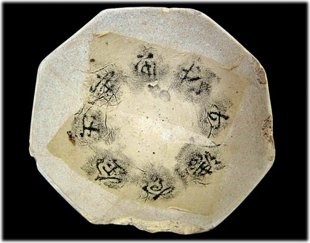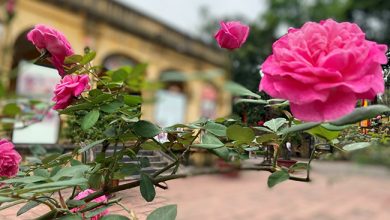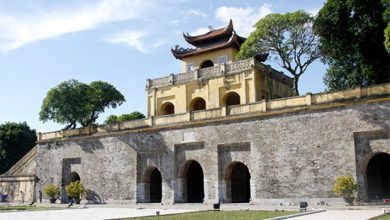The plate bearing the stamp of Buddhism
A plate in the shape of 8 edges with8 engraved Chinese characters is considered to be utensil in the Royal palace and relate to the Buddhism.
According to archaeologist Bui Vinh, among the variety of Vietnamese porcelain wares were excavated in 2008 at Tran Phu site (Ba Dinh, Hanoi), there was a very precious and rare porcelain ware which could only be used in the Royal palace and certainly related to the Buddhism. It was the plate in the shape of 8 edges with 8 engraved Chinese characters. This discovery was publicized by Mr. Vinh at the Conference on archaeology in 2012.
The plate bearing the stamp of Buddhism – Image: Bui Vinh
According to Mr. Vinh, three specimens of dishes, included two bowls and one plate, have currently been detected in Tran Phu site. All are white mixed green funnel-shaped potteries. Their body and mouth are in shape of 8 edge octagon, low support, male bottom, and flat edge. Inside such dishes, there are 5 triangle footmarks bearing features of porcelain dishes of Tran dynasty in the 14th century.
What are eight Chinese characters?
According to Mr. Vinh, three dishes were engraved with 8 Chinese characters which were distributed on 8 edges around the heart of bowls and plate. Regretfully, there are 2 dishes of which 2- 3 characters are broken. The remaining has enough 8 characters but 2 characters are lacked of line because of unclear engraving. Such incompletion has readers guess such characters. In reality, at the conference, there were many different opinions on the way of reading such characters that was originated from being difficult to read.
However, Mr. Vinh reported that some sinologists, included Professor Ha Van Tan, MA Pham Le Huy and MA Dang Hong Son, have currently studied directly 2 bowls. Their common opinion is to unify to confirm raised letters which were engraved in the heart of such articles.
Accordingly, 3 characters on the bowl are broken; the 5 remaining characters are “Bảo – Kim – Thực – Bát – Giác”. The bowl with sufficient 8 characters, of which 2 characters are lacked of line, is guessed as follows: “Bảo – Ngọc – Kim – Thực – Thanh – Nữ – Bát – Giác”. “Therefore, sequence of characters on such two bowls is rather different from each other but their contents show that they are precious and rare articles. Of course, more studies are required to understand accurately the meaning of such characters, particularly in the field of Buddhism”, said Mr. Vinh.
Exchanging with Thanh Nien, Mr.Vinh said that, we should not forget that Tran dynasty culture is the culture of Dhyana. Therefore, Dhyana ideology was penetrated deeply in all living aspects. The King and people in Tran dynasty were devout Buddhism. That is the reason to confirm that such bowls and plates were made to serve Buddhists in the Royal palace. “Tran dynasty showed clearly the opinion that the Buddhism begins the world. A King in Tran dynasty became Buddha- Royal Buddha Tran Nhan Tong”.
The Buddhism factor on porcelain wares as well as the Central Sector of Imperial Citadel of Thang Long- Hanoi has been mentioned for many times. Professor Phan Huy Le, Chairman of the Vietnam Association of Historical Sciences, in one of his lectures, stated that the Buddhism ideology and art have not only been present at Thang Long Imperial Citadel but also contributed importantly to form the unique value of the heritage, being clear expression of cultural interference.
Professor Le also stated that the Buddhism was stamped on the whole heritage, particularly in Ly- Tran dynasty when the Buddhism played the key role. The Buddhism architecture with many towers and pagodas was present even in Forbidden City; particularly a brick in Tran dynasty was engraved with “Hung Hoa Dhyana pagoda” which was meant that there was Hung Hoa pagoda in the Forbidden City in Tran dynasty although there was no documents of such pagoda. The royal palace decoration art was with image of Buddhism with the appearance of lotus and snowbell leaf which are Buddhism typical “symbols”.
On such cultural basis, the appearance of dishes bearing the stamp of Buddhism is not strange. Particularly, Mr. Vinh added that type of such dishes in the shape of 8 edges with 8 engraved Chinese character have been detected in 18 Hoang Dieu archaeological monuments. Of which there were plates of Tran dynasty with white enamel outside and brown enamel inside- a “beauty destroying” color according to Buddhism. Beauty destroying color, according to Mr. Vinh, even is not considered as a color from the viewpoint of the Buddhism and rarely used in decoration.






